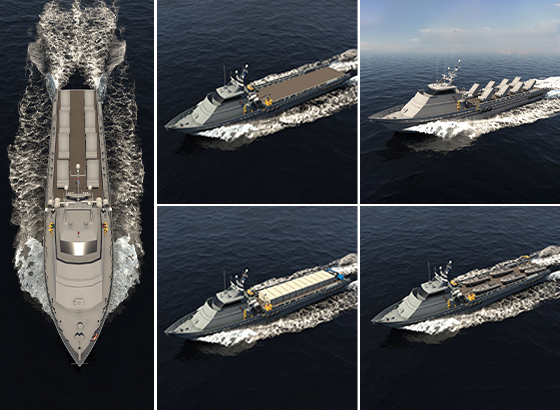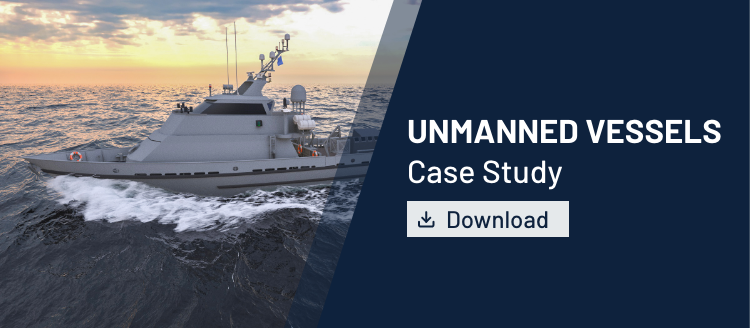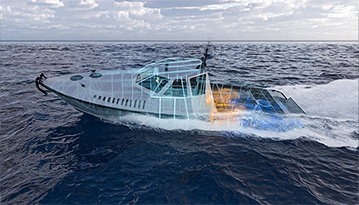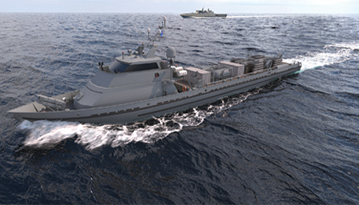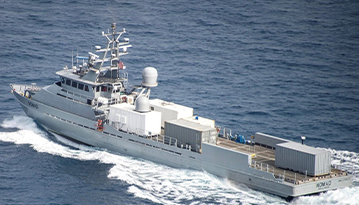IMPACT STUDY
Unmanned Vessels
Pioneer in USV Market Small to Large USVs R&D, New Built and Conversion
Overview
Swiftships has pioneered in multiple disciplines, helping the US Navy to expedite the development, testing, and deployment of Unmanned Surface Vehicles (USVs) into its fleet. It began investing in testing autonomous platforms before 2005, and its name became central to conversations around autonomous vessels following the US Navy’s 2018 selection of the Swiftships’ Riley Claire – a 175-feet Fast Supply Vessel (FSV) – for transformation into a Large Unmanned Surface Vessel (LUSV), named “Nomad”. Nomad became the first unmanned vessel of its kind added to Unmanned Surface Vessel Division One (USVDIV-1) and has undergone thorough testing during autonomous missions.
Swiftships designs and constructs small to large autonomous vessels and offers commercial platform conversion to militarized unmanned/minimally manned vessels. It has developed many variants of its Fast Supply Vessels (FSVs), not only for fully autonomous operations but also for minimally manned or remote-controlled operations of the craft. Swiftships offers its clients turnkey solutions, including the development of custom-tailored conventional or autonomous platforms, with full vessel lifecycle sustainment, and Maintenance, Repair, and Overhaul (MRO) services, which will help navies modernize their fleets while reducing costs.
Highlights

Full Lifecycle Solutions
We provide R&D, engineering, building and sustainment of unmanned vessels

Mission Flexibility
Modular platforms that allow various mission configurations

Market Leader
Pioneer in autonomous platform conversion, and leader in SUSV development

Cost-Saving and Reliable
Swiftships autonomous vessels are highly endurant, efficient and low-maintenance
Expertise
With over 80 years of experience delivering diverse platforms, including small to large military and commercial vessels, and pioneering in the autonomous market, Swiftships is capable of offering full lifecycle solutions for unmanned/minimally manned vessel development and maintenance. Swiftships’ expertise includes research, development, and innovation for highly capable Unmanned Surface Vehicles (USVs), engineering, vessel construction/conversion, and system integration, supplemented by Maintenance, Repair, and Overhaul (MRO) services. Its experience extends from ship exterior modifications to the most complicated machinery and electrical (HME) components, electronics, communication and navigation (COM/NAV) systems, and weapons systems, as well as numerous system overhauls, servicing, and upgrades. Understanding military clients’ requirements, highly developed infrastructure, and knowledgeable personnel allow the company to adapt and innovate in the quickly evolving dynamics of the naval industry and its needs for autonomous capabilities.
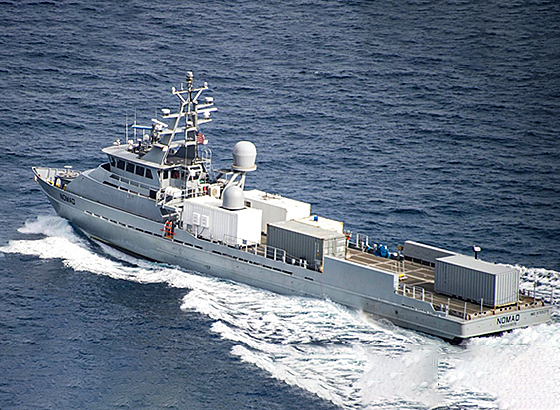
Approach
Platform as a Service
The Navy’s latest plan is to increase its fleet by about 150 unmanned surface and underwater vehicles by 2045. The acquisition strategy is based on building new design medium to large unmanned vessels and converting already proven platforms to militarized unmanned/minimally manned vessels. Swiftships provides construction of prototypes and conversion of its proven platforms services to the US Navy and allied nations, offering its unique competitive advantage of over 100 proprietary designs with all test data and experienced in-house engineering team. Swiftships’ experience and proven methodology for autonomous systems integration include physical, electrical, and data interfaces between payloads and the platform, payload launch and recovery systems complimentary to USV capabilities and development. In addition to the platform, Swiftships offers a full suite of services: cybersecurity, engineering, product support, and payload and weapons systems integration.
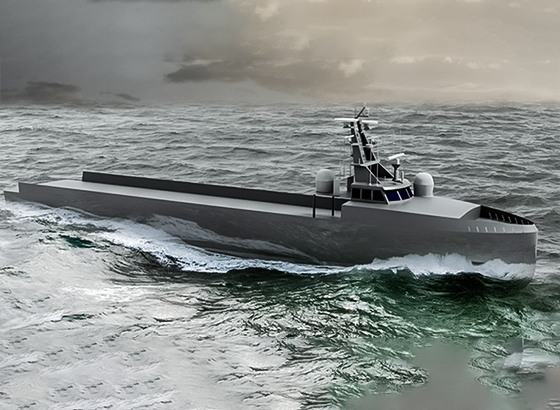
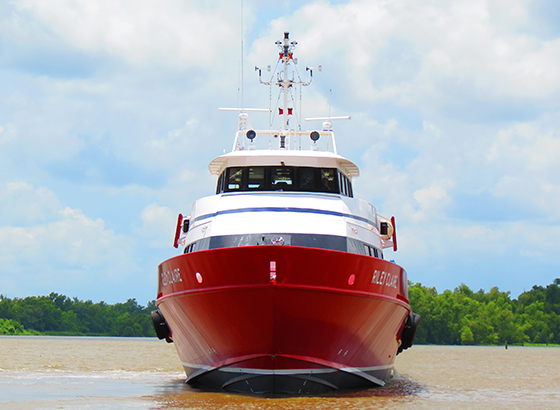
Platform Conversion
Proven commercial platform conversion to militarized autonomous or minimally manned vessels is a reliable and efficient option for navies to accelerate their move to unmanned fleets. Swiftships has developed numerous configurations for its Fast Supply Vessel (FSV). When outfitted with missile defense systems, mission modules, UUVs, and UAVs with spoke or launching and retrieval capabilities, these relatively medium-sized vessels can accomplish many missions simultaneously, such as surface and underwater warfare. Militarized unmanned platforms can also serve as AAW/Strike Platforms and enhance the power of flagship vessels. A proven case is the conversion of Swiftships’ FSV Riley Claire to the militarized unmanned vessel Nomad, and its performance on autonomous missions.
Nomad traveled from the Gulf Coast through the canal to the U.S. West Coast, covering a total of 4,421 nautical miles, with 98% of that distance in autonomous mode and the Panama Canal in manual mode. Nomad’s autonomous transit provided the opportunity to test vessel endurance, autonomous operations, and the interoperability of government command, control, communications, computers, and intelligence systems. Nomad is part of the Rim of the Pacific 2022 manned-unmanned teaming experimentation exercise.
SUVS Market Gaps and Development
While there are many SUV designs in the market, defense industry requirements constantly evolve, and many SUVs fail to meet mission requirements. Swiftships has been working closely with its military clients to define SUV missions and technical requirements.
In early 2022, Swiftships unveiled its 46’ Small Unmanned Surface Vehicle (SUSV), aka Challenger, an unmanned vessel designed on a proven platform that has served in various military and commercial engagements for over 20 years. Challenger offers a speed of over 45 knots, extreme endurance, and can be configured for multiple missions, including strategic strike and mine countermeasure/sonar deployments. Multi-modal situational awareness aboard the ship allows for threat-based object recognition, while further tracking, high-speed data connectivity, and anti-collision capabilities will help the United States (US) Navy Fleet Forces Command (FFC) meet its mission of achieving fully autonomous capability.
Another major development in 2022 was the 35-foot Riverine Assault Craft (RAC35) prototype design and construction for the Marine Forces Reserve. The effort was accomplished in partnership with the Defense Innovation Unit (DIU). RAC is a USMC proven platform, capable of operating in tropical regions with assured top performance in sustained ambient air temperatures over 100°F. RAC35 is designed to conduct littoral/distributed operations and is capable of performing reconnaissance, sensing, tactical maneuver, and logistics support in the maritime domain, in both international deep blue waters and coastal/riverine zones. The RAC35 is a revolutionary platform due to its extreme endurance, speed, minimal signature, ability to support manned/unmanned assets (over 100-200 nodes via 5G.MIL® Lockheed Martin), and affordability.
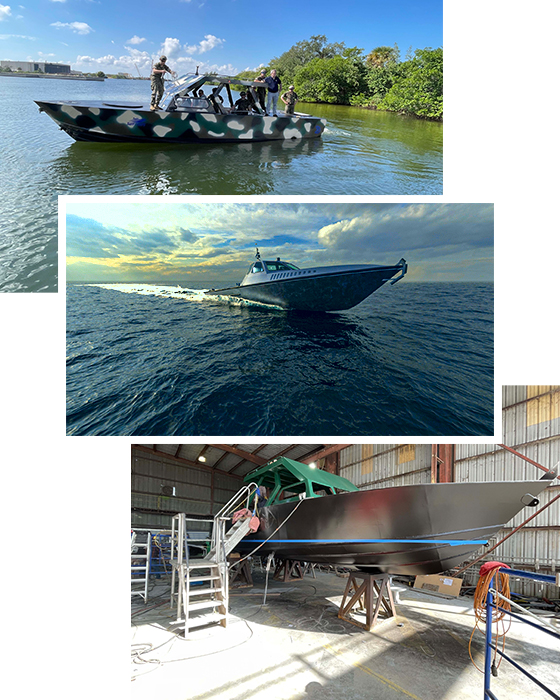
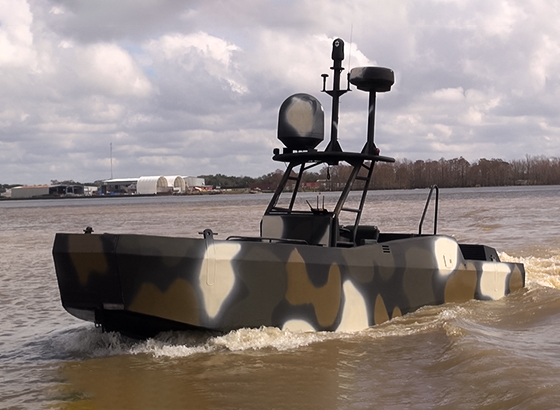
Unmanned Systems and Technology
Swiftships took its first step into the autonomous vessels market in early 2015 when it collaborated with the University of Louisiana at Lafayette (ULL) to develop remote-controlled and unmanned systems for SUVS, also known as Anaconda (AN-2). The unmanned system has been enhanced to ensure the vessel’s capability to continue operating even if a casualty occurs during combat. Swiftships’ work continues to integrate edge processing, artificial intelligence, and machine learning into the system to enable filtering and processing mission data on board and adapt to any situation and environment.
Swiftships is a full-service solution provider of complex support systems utilizing laser cameras (EO/IR). These sophisticated sonar systems gauge sea states and detect obstacles in the water, maintain state-of-the-art weapons systems, oversee Integrated Bridge Solutions (IBS), and provide platform solutions, maintenance, and training to ensure successful interoperability. Swiftships’ dynamic multiplier platforms offer 4G/5G, line-of-sight, over-the-horizon, and satellite communication. The advanced sensors package allows for the instant capture and transfer of live information, creating a near-sentient computer system that reacts and makes highly accurate steering, accelerating, and high-speed maneuvering decisions while accounting for scenarios such as port security, mine countermeasures, surveillance, and more.
Autonomy Integration to Naval Platforms
Autonomous solutions are already highly used for intelligence gathering, surveillance, and reconnaissance, mine countermeasures, military training, and tests. Swiftships is working with its technology partners on reliable solutions for integrating unmanned systems into naval platforms, offering advanced capabilities in maritime security, anti-submarine warfare, drug interdictions, and the launch and recovery of host platforms.
Swiftships’ current experience in building Medium Unmanned Surface Vessels (MUSVs) alongside L3 Harris (as the Prime contractor) gives the company unparalleled expertise. The MUSV is a first-of-its-kind vessel designed to meet the current and future changing needs of navies and the shift toward a more autonomous fleet. The U.S. Navy is delighted with the progress of the design and the prototype underway. This experience, paired with Swiftships’ expertise in system integration, positions the company as one of the top shipyards for the future.
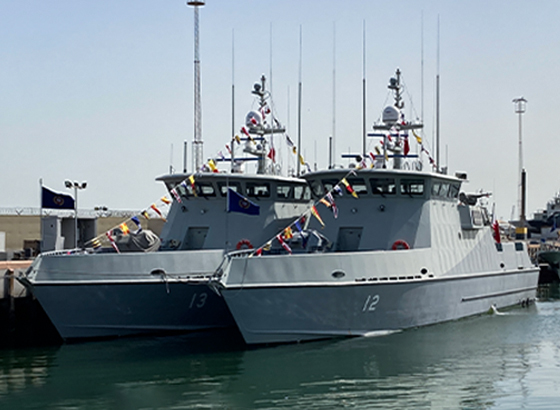
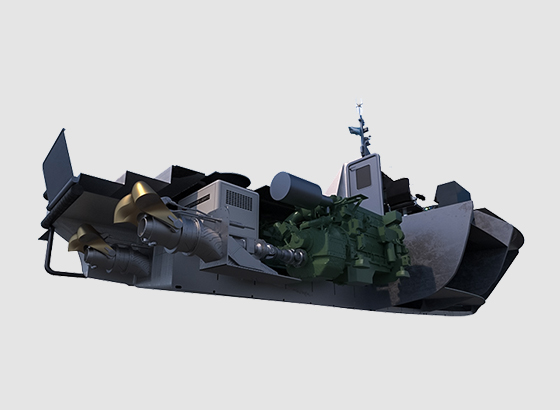
Unmanned Vessels’ Life Cycle Sustainment
Unmanned vessels, like any platform, require a sustainment structure and maintenance to ensure their longevity. Swiftships provides a comprehensive range of reliable and cost-effective maintenance packages, covering planned or predictive, preventative, corrective, and continuous maintenance. Our expertise extends to all aspects of unmanned vessel care, from exterior upgrades to the most intricate machinery and electrical (HME) systems, electronics, communication and navigation (COM/NAV) equipment, weapons systems, and other critical components. Different packages cater to various maritime needs, offering a tailored approach to servicing, upgrades, overhauls, and repairs.
Conclusions
Vessels, ranging in size from a corvette to medium or small-sized craft, will, by 2045, define the modern fleet, with autonomy playing a key role. Recent advancements allow for leveraging naval platforms that are far less expensive to build, operate, and maintain. These advances, while helping nations project power, are also meeting critical humanitarian needs, leading to lower casualty rates in terms of human life and a heightened level of security in naval infrastructures across the globe.
Swiftships is perfectly positioned to provide full lifecycle solutions for different sizes of unmanned vessels as modern naval warfare continues to evolve.
